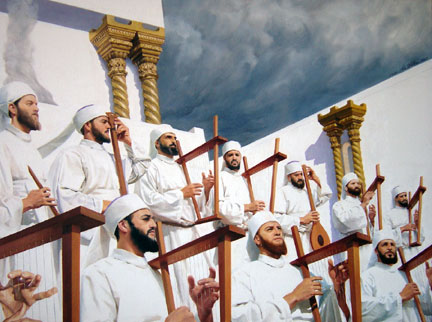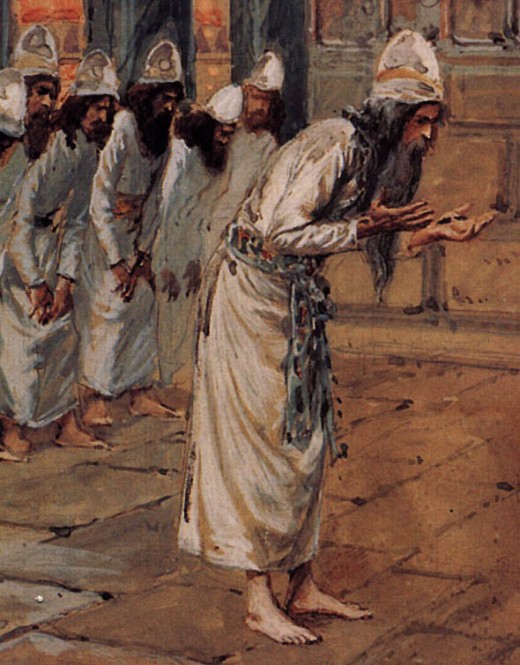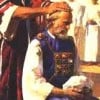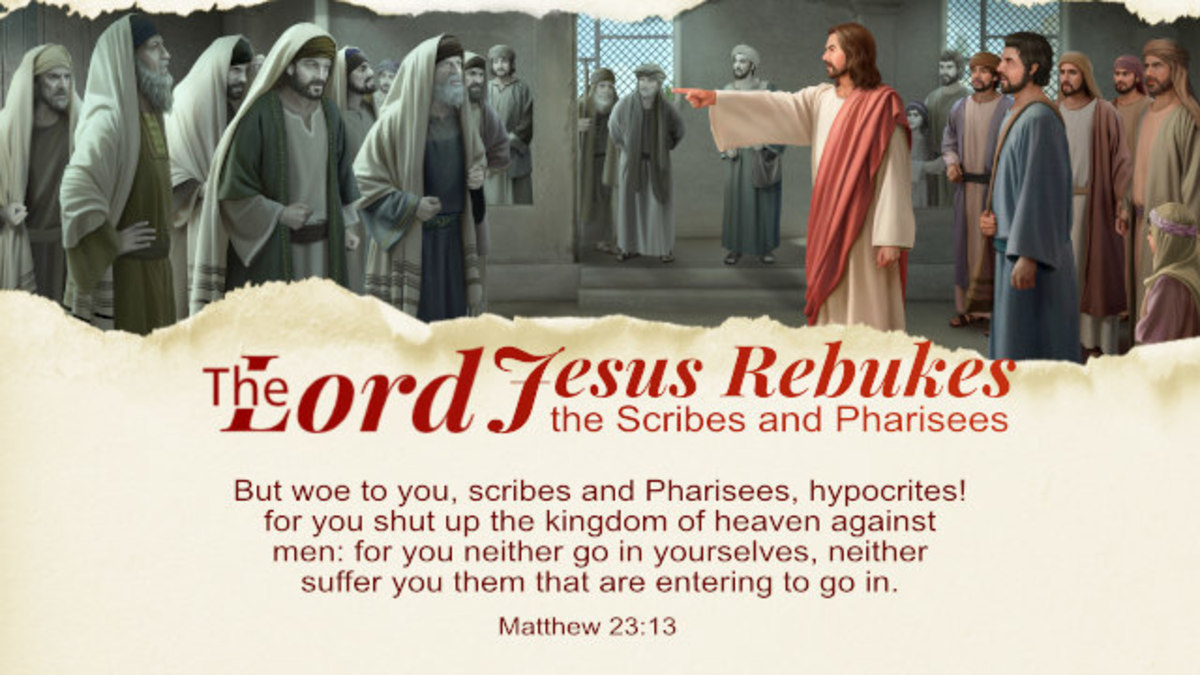Priest Wars
There is a battle raging. It has been waged for over twenty centuries but in spite of its terribly long endurance, so few are even aware of its existence. Even within my own family there are those that have forgotten our past, what we have suffered, what anguish we have borne, how many of our line have died, not from the weapons of the outside world but from the knives held in the hands of brothers, twisted sharply in our backs. Like so many revolts or rebellions throughout history it began when those referred to as ‘new men’ gained power through wealth, force of arms, or political machinations and challenged those that had hereditary authority. And we are well aware how those situations ended, whether they were the American, French or Russian revolutions, just to name a few. Those with hereditary rights often forfeited not only their claims but their lives as well to those having no rights at all other than the desire to be in charge and usurp authority.
This was no different amongst the Jews of the second century BCE. Thousands of priests born to privilege, supported by the tithes while so many scholars whom considered themselves far better gifted with greater knowledge barely scratched out a living surviving from a few coins tossed their way by any seeking their opinion. How terrible it must have been for these scholars whose families would have paid for their years of schooling under the tutelages of famous sages or tannim, only to be faced with the prospect of personal bankruptcy when there were no positions available in which to display their knowledge; knowledge which in their own minds was greater than any of those prissified priests that did nothing to merit or deserve their positions of scribal authoritativeness and seats of judgment other than have the good fortune to be born into the proper family. How this must have galled them and infuriated them to the point of infraction and insurrection. Surely Exodus 19:5-6 referred to them as well and the priests merely denied them what was rightfully theirs. Was not God saying that Israel was a nation of priests, a holy nation, not just a reference to a theocratic society whereby a few people born into priesthood ruled over the remainder? And even though the term for the priest, Cohen, was based on certain core Semitic language meanings that implied an intermediary, certainly this wasn’t intentional as God would have wished anyone with knowledge of the Torah to act on behalf of the people. It was this refusal to accept what God had commanded that fuelled what began as a silent uprising and ended in the destruction of God’s own laws.

The Tribe of Levi
It cannot be much clearer than in Numbers 18:7 that it was God’s intention that the House of Aaron of the Tribe of Levi held the hereditary priestly privilege for an eternity. It did not matter if a Temple stood for in the desert there was no Temple, only the tabernacle which moved freely wherever the people were. A situation no different today with the scattering of the people throughout the Diaspora, yet the rabbis for two thousand years refused to accept this fact claiming the priesthood could only be restored if the Temple existed, clearly in contravention to God’s own instructions and in doing so they have led the people falsely into the incorrectness of their belief. A belief based entirely on personal reasons why these Rabbanites refuse to obey and accept the divine commands. Commands that clearly state that from this particular family, certain select subgroups would provide the High Priest for all the future generations. This was a family that had to be approved through specific bodily qualifications, functional qualifications, hereditary qualifications, and purity qualifications, all which made it stand separate from the remnant of Israel and to the exclusion of these schooled and unofficially ordained professors of the law that had no real opportunity to break through into the halls of religious officialdom because they lacked the aforementioned prerequisites; prerequisites not laid down by their school masters but by the Almighty God. How frustrating it must have been for them to recognize that there were twenty-four courses of family entitled to share in the office as laid down by King David and for them there would never be the opportunity to ever belong to any of them. Not even the failure for most of these courses of family to return from the Babylonian exile provided a possible opening for anyone other than a tribal Levite to serve as intermediary between man and God. Only the families of Jedaiah, Immer, Pashur and Harim, according to Ezra as witnessed in Ezra II ever returned, barely enough to officiate and still no invitation to join them in their duties to these others that considered themselves deserving of such honour. Both Ezra and Nehemiah pointed out that it was the lay priests, the Levites, whom were so short in numbers that their absences threatened those ancillary services required within the Temple. According to the Talmudic stories by the Rabbis this was a travesty of huge magnitude. So much so that they said Ezra cancelled the tithes that were to be delivered to those remaining courses of Levites that failed to return. I doubt very much it was a cancellation of the tithes as merely the fact that those courses were not even present to receive those tithes as would be the case if they were officiating in the Temple. Hard to actually give any ‘wages’ to someone not even present but the real point here was that the rabbis wanted to demonstrate that even those born to a hereditary position could be stripped of those rights and privileges and it was within the authority of men to do so. Within the authority of men to cancel the word of God that is what the rabbis were proclaiming they had the power to do and sadly so many of the populace have believed them in their lie.

The Nethinim
As if to infuriate these refused and rejected scholars even further was the fact that Ezra appointed the Nethinim to fill the gap that remained due to failure of the Levite return. Contrary to the Talmudic claims that these Nethinim were bastards or the garbage of society, a clear indication of the rabbis’ displeasure at their still being overlooked for any Temple positions. We can see from Numbers 8:19 that it was a term used in reference to a servitude class of Levites themselves. But what kind of Levites were they, these hewers of wood, these water bearers, these labourers of no apparent skills that would render them worthy of serving within the Temple on a religious nature. The Tanach carefully records their return in the sense that it was a most prestigious event. They are recorded as returning to Judea, after the Exile, in two batches, one numbering 392 and the second 220 (Ezra 2:58, 8:20). What is worthy to note is that the second batch returned not from Babylon but from a place in Persia called Casiphia and they could trace back their services within the Temple to a time of David and the Princes. It should be appreciated that Casiphia was an area of northwest Mesopotamia. Assyria was also an Empire located in northwest Mesopotamia. This fact alone should provide a clearer indication of whom the Nephinim (those set apart as the name implies) truly were.
We can ignore the notations in the Talmud in which the Nethinim are portrayed
as the equivalent of bastards, and that their descendants both male and
female, were prohibited from marriage with the Children of Israel for all
time (Yeb. ii. 4, viii. 3). The rabbis
claim that this prohibition was established by David (Yeb. 78b) only to
contradict themselves later in Ezra (Num. R. viii.) but again this is another
demonstration of their inconsistencies and their constant ignoring of what is
written in the Tanach in order to create their own fables and versions which
they then used to convince the people of the accuracy of their statements. The falsehood of the Talmudic
statements can be observed when one reads according to Nehemiah 10:28 and following
that the Nethinim were loyal to the covenant of God's law and avoided mixed
marriages. Hard to be both loyal to
the covenant, avoiding mixed marriages and be prohibited to marry an
Israelite at the same time. The fact
is that we know so little of the Nethinim over the centuries that followed
Ezra because there was nothing to make them distinct from the general
populace. So in another attempt to justify the low status given
to the Nethinim in the Talmud the rabbis suggest that they are actually the Gibeonites that
surrendered to Joshua (Yeb. ii. 4; Ḳid. iv. 1) and even though there is
nothing to suggest that this is true, even if it were, how many generations
of servitude would be inflicted on a subjugated people considering the Torah
prohibits lifelong slavery or servitude and demands emancipation after set
times. The laws of slavery were well known to the rabbis and therefore they
knew their accusation was false as soon as it parted from their lips.
But still not willing to accept that the Nethinim were rightfully integrated into the Temple services the rabbis further insisted that they were only allowed to marry proselytes, freedmen, bastards, and foundlings (Ḳid. viii. 3). And furthermore in the tables of precedence they were reckoned as being very low, coming after bastards in Yer. Hor. iii. 5 and Yer. Yeb., viii. 5. Let’s not overlook the fact that these Nethinim served in the Temple, were considered a Levitical class, and these Pharisaic scholars were not. So if the Nethinim were at the bottom rung of society, then where exactly would this place the rabbis who were not even considered fit to fill the Nethinim positions?
Still unwilling to admit that these Nethinim were perhaps deserving of their positions the rabbis undertook yet another tactic of trying to explain the seeming contradiction of union of sacred service and social ostracism by suggesting the Nethinim were the descendants of the Ḳedeshot, or sacred prostitutes. Now those of us familiar with the Temple services know very well that unlike other religions there were no Temple prostitutes in Judaism. The mere suggestion of such a practice by the rabbis is an affront and offence to our ancestors, our people and especially to God. To denigrate the Temple in such a manner is beyond comprehension, especially by men who claim they are both masters and scholars of the Torah. It is irreprehensible and totally irresponsible but once again demonstrates the extent these Rabbanite leaders will go in order to undermine the priesthood in an attempt to prove their own worth and merit.
In order to more appropriately assess the Nethinim and understand the loathing animosity directed towards them by the Pharisim and rabbis then we must refer back to the early statements by Ezra that not only were they deserving of the positions having held them in the days of David and the Princes but were from Casiphia. These were obviously men ‘set apart’ as their name implied, no differently from the descendants of Aaron that were set apart. The fact that they would have provided services in the Tabernacle and during the days of Adonijah, Absolom and Solomon most likely provided similar services in the first Temple as well cannot be dismissed. But then something happened. They became separate and ultimately ended up in northwest Mesopotamia in a location not too far away from the ancient empire of the Assyrians. How is it that a people that had held positions in the first Temple would end up in the Assyrian exile of Northern Israel? Quite simple since we know that when Jereboam split the north off from the Reheboam’s Kingdom of Judah he set up his own religious sanctuary and convinced Levites and Cohens from the south to administer in his new kingdom. In most likelihood, the Nethinim were nothing more than those priests that had gone to the Kingdom of Israel to serve there and for that reason had earned the scorn and disrespect of many in the southern kingdom.
Herodian Times
By the time of Herod’s Temple the hatred and contempt with which the Pharisees-rabbis held the priesthood was clearly evident. Already jealous of their exclusion from Temple services, the Pharisees still held the bitter memories of the events one hundred years earlier when they were killed in the hundreds by the actions of certain Hasmonean Kings whom were merely by their evaluation nothing more than priests that had become power hungry and depraved, an insinuation which accordingly earned them the wrath of these priest-kings. Of course the constant protests by the Pharisees regarding the freedom of taxation that was granted to the Cohens, Levites and even the Nethinim had something to do with earning the wrath of the Hasmoneans. As well as their complaints that these same sons of Aaron were also freed from military service in a time when the Hasmoneans freely conscripted these Rabbanites into their wars of expansion. But what probably earned them the chief animosity of the priest-kings was their accusation that these Hasmonean kings had actually defiled the Temple, serving as High priests while guilty of committing murder. This was by no means a harmless accusation because the punishment for such a crime based on the Torah was for the priest to be dragged from the Temple and beaten to death. So it was not difficult to understand the determination of the Hasmoneans to silence these men that were in fact calling for their deaths. Nor the corresponding hatred with which the rabbis now bore the Sadducees in what had by all rights become a battle to the bitter end.
With the advancement of the Herodians into the courts, the power of the Hasmoneans was slowly being eroded and broken. In fact two Hasmonean brothers began a civil war in their efforts to claim the kingship which provided the Pharisees the opportunity to negotiate their allegiances in exchange for more authority and control of the Sanhedrin court. Immediately the rabbis passed a law that now advocated that privilege to sit on the Sanhedrin could only be obtained by traditional learning. And subsequently pronounced that only they, the Pharisees, as the only promulgators of traditional learning had any status before God and before man since they were the true teachers of the Law. They then made the pronouncement that any man that does not know the law is cursed and began to divide the members of the priesthood in to those they considered lettered and those they did not. The more their power grew in the Sanhedrin, the more restrictions they could place over the priesthood. Priests had to pass a test of fitness, established and administered by the Pharisees and those that failed were officially removed from the priesthood. Soon, the local priests that officiated in the community synagogues found themselves replaced by ‘learned’ men that had no hereditary connection to the tribe of Levi but happened to all be members of the Pharisee party. The rabbis made it publicly known that they considered a scholar even though he may be a bastard was of higher standing and value than an unlearned high priest. Where once the High Priest was chosen by his standing amongst the select families, it now became an appointment by the men of the Sanhedrin thus removing the father to son lineage. In the Talmud, Ioma I, the rabbis describe the High Priesthood as follows: “In the first Temple the high priests served, the son succeeding the father and they were eighteen in number. But in the second Temple they got the high priesthood for money, and there are those that say they destroyed each other by witchcraft.” Publicly the rabbis had denounced the priesthood for corruption and black magic, an accusation which if accepted by the people would mean the death of the priesthood as there was no greater crime than the practiced of witchcraft. It was a deliberate attempt on the part of the rabbis, to make what would become a permanent accusation in their Talmud to justify an end to the Sons of Aaron.
The Sanhedrin under the control of the Pharisees then began to disqualify priests on the basis of their genealogy. As long as the father’s name of the priest was inscribed in the archives of Jeshana at Zipporim, then they could not disprove his claim, but if it was not there, then they would declare the candidate as illegitimate, dress him in black and permanently remove his family from his tribal affiliation. And even those that did pass their inquisition would then have to prove they had no physical defects an onerous task as we know from Maimonides recording that there were one hundred and forty defects that permanently disqualified them and twenty-two which did so temporarily. The anointing of priests was abolished and so those that managed to pass these new guidelines were only invested by having their names recorded on a new register permanently in control by the rabbis. But there was more to this investiture replacement of the anointing ritual. Without the anointing the rabbis could declare that the priests no longer possessed the power of the Urim and Thummim, the ability to call on God to render a decision directly. It was the final act of degradation and the termination of any hereditary authority that was once possessed by the High Priest.
Conclusions
As can be seen, this battle for the authority to teach the law, to serve God and to intercede on behalf of the Children of Israel has been perpetrated for a considerable length of time. But have no fear. Though reduced to a pale reflection of what it once was, the priesthood still exists partly due to the fact that the rabbis still maintained their markedly reduced register of names. But more importantly even though they no longer had any official capacity in the synagogues, fathers both Levite and Cohenim still told their sons from one generation to the next of their heritage. Oh, the rabbis could dress us in black and try to shame us before the people but not even their actions could remove the one oral tradition that God insisted upon and that was the telling of lineage from father to son. Such a thing did not have to be written and recorded by the rabbis for it is inscribed upon the heart. Amongst the Karaites there was never a question of abandoning the priesthood, and they are still held in reverence as was insisted upon in the Torah. As Karaites we have not attempted to usurp the God-given authority from Aaron’s sons nor would we ever have been so contemptuous of God’s commandments to have attempted to do so. From the book of Zechariah we know how important it is that the priesthood be preserved, a warning easily forgotten and overlooked by the rabbis that choose to ignore and give no acknowledgement to the Aaronic Messiah. Let them do so for in the end this battle will be won once and for all and the Kahana will once again serve as they were intended.








